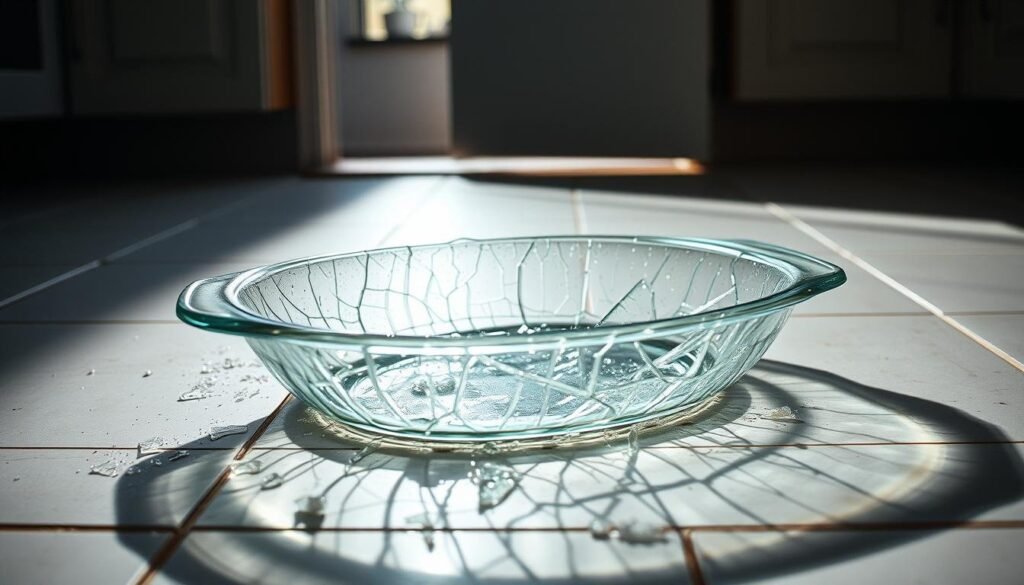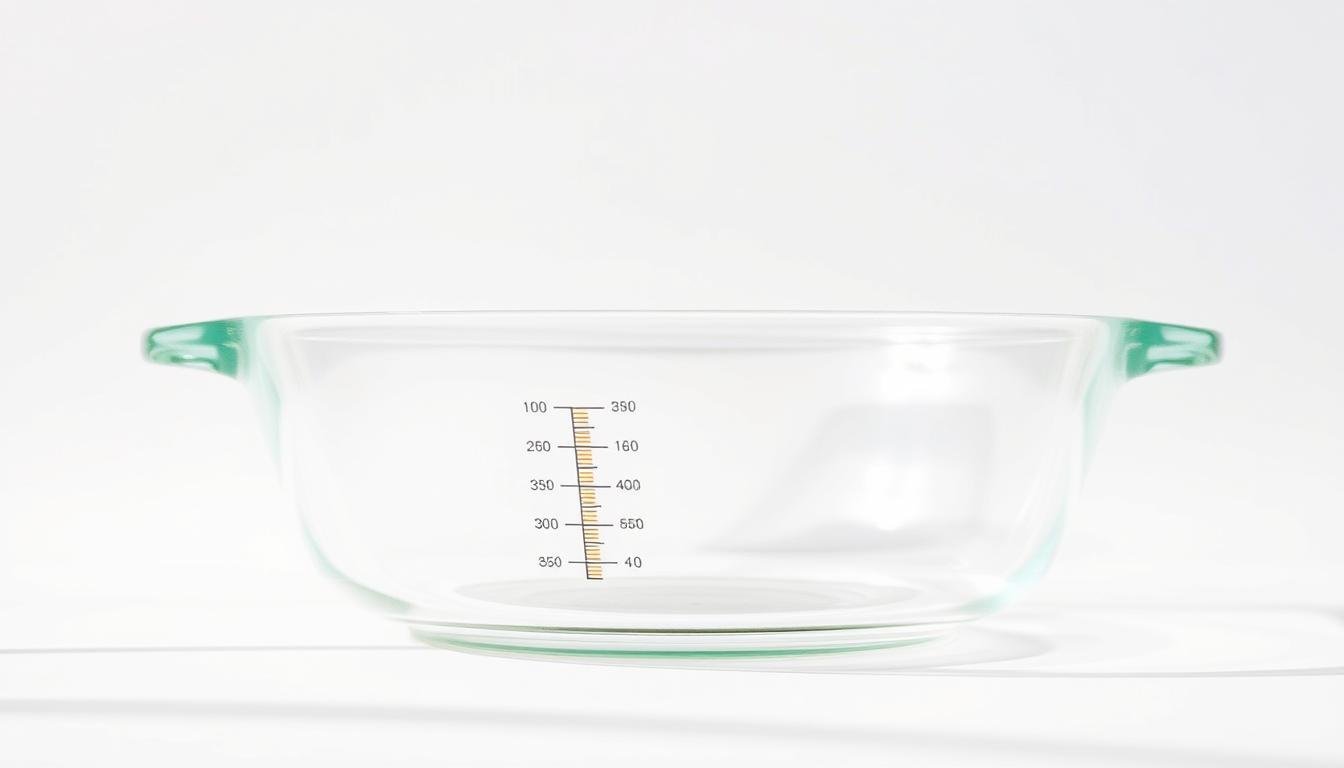Last updated on August 11th, 2025 at 03:44 pm
Put a Cold Pyrex Dish in the Oven: Pyrex dishes are a favorite for many home cooks. But, there’s often confusion about their safe use, especially with oven temperature and Pyrex safety.
Putting a cold Pyrex dish straight into the oven can be risky. The sudden heat change might make the glass break. Knowing the risks and taking the right steps can help you use your Pyrex dishes safely.
Learning how to use Pyrex in the oven is important. You’ll find out how to avoid mistakes and make sure your cookware can handle high oven temperatures.
Contents
- 1 Understanding Pyrex: What Makes It Special
- 2 Can You Put a Cold Pyrex Dish in the Oven?
- 3 The Science Behind Thermal Shock
- 4 Old vs. New Pyrex: Important Differences
- 5 Best Practices for Using Pyrex Safely
- 6 Common Mistakes That Lead to Pyrex Breakage
- 7 Alternative Cookware Options for Temperature Transitions
- 8 Conclusion: Put a Cold Pyrex Dish in the Oven
- 9 FAQ
- 9.1 Can I put a cold Pyrex dish directly into the oven?
- 9.2 What is Pyrex made of?
- 9.3 What is thermal shock, and how can I prevent it?
- 9.4 Are older Pyrex dishes safer to use than newer ones?
- 9.5 Can I use a baking mat or rack with my Pyrex dish?
- 9.6 What are some alternative cookware options for extreme temperature transitions?
- 9.7 How can I safely handle hot Pyrex dishes?
- 9.8 Can I put Pyrex dishes in the freezer?
Understanding Pyrex: What Makes It Special
Pyrex bakeware is loved for its special material and how it doesn’t react with food. It’s made from borosilicate glass. This glass is known for being very strong and able to handle heat well.
Pyrex is great because it heats evenly. This means your baked goods will cook the same everywhere. Also, Pyrex won’t mix flavors or chemicals with your food. This makes it safe for baking.
| Material | Thermal Resistance | Non-Reactive |
|---|---|---|
| Borosilicate Glass | High | Yes |
To keep your Pyrex bakeware in good shape, you need to take care of it. Don’t change the temperature too fast. Also, clean it gently. This helps it stay safe and work well.
Knowing what makes Pyrex special helps you use it better. You’ll have safer and more effective baking.
Can You Put a Cold Pyrex Dish in the Oven?
Many people wonder if they can put a cold Pyrex dish in the oven. This question is key for safe cooking.
Pyrex says it’s okay to put a cold Pyrex dish in the oven, but be careful. Thermal shock is the main worry. It happens when the dish goes from cold to hot too fast, which can make it break.
- Make sure your Pyrex dish is borosilicate glass. It’s better at handling sudden temperature changes.
- Don’t put a Pyrex dish straight from the freezer into the oven. Let it warm up a bit first.
- Heat your oven slowly and avoid big temperature changes.
| Glass Type | Thermal Shock Resistance | Common Use |
|---|---|---|
| Borosilicate Glass | High | Pyrex dishes, laboratory equipment |
| Soda-Lime Glass | Low | Some older Pyrex models, decorative glassware |
Knowing your Pyrex dish’s glass type and following the maker’s advice helps you use it safely. This way, you can cook many dishes with your Pyrex.
The Science Behind Thermal Shock
When you expose a Pyrex dish to drastic temperature changes, you risk a serious failure called thermal shock. This happens when a material, like Pyrex, faces sudden and extreme temperature shifts. It causes stress within the material.
Pyrex is made from borosilicate glass. This type of glass is more resistant to thermal shock than regular glass. But, it’s not completely safe from sudden temperature changes.
Expansion and Contraction Rates
Different materials expand and contract at different rates when temperature changes. Borosilicate glass, used in Pyrex, has a low coefficient of thermal expansion. This means it expands and contracts less than other materials when heated or cooled.
Knowing how Pyrex expands and contracts is key to safe use. By understanding these factors, you can take steps to avoid thermal shock. This helps keep your Pyrex dishes durable.
Old vs. New Pyrex: Important Differences
It’s important to know the differences between old and new Pyrex for safe use. Pyrex has changed its making process over time. This change affects how well and safely their bakeware works.
Old Pyrex dishes were made from borosilicate glass. This glass is great for handling sudden temperature changes. But, new Pyrex is made from tempered soda-lime glass. It’s still safe for baking but not as good at handling temperature changes.
Old Pyrex dishes can handle extreme temperature changes better. But, new Pyrex needs more care because it’s more likely to break from sudden temperature changes. Always follow the maker’s rules for temperature changes to keep your Pyrex safe.
Also, old Pyrex dishes might have a different non-stick coating or no coating at all. This is different from new Pyrex. It changes how you clean and take care of your Pyrex dishes.
In short, both old and new Pyrex have their good points. But knowing their differences is crucial for safe and effective use. Always check the maker’s instructions for your Pyrex bakeware.
Best Practices for Using Pyrex Safely
Understanding how to use Pyrex safely is key to avoiding accidents. You can cook safely with Pyrex by following a few easy steps.
Room Temperature Transitions
It’s important to handle temperature changes carefully to avoid thermal shock. Don’t put a cold Pyrex dish straight into a hot oven. Let it sit at room temperature first.
This slow transition reduces the chance of the glass breaking. You can also preheat your Pyrex dish in a cool oven. Slowly increase the temperature to avoid thermal shock.
Using baking mats and racks can make cooking with Pyrex safer. These tools help spread heat evenly, lowering the risk of the glass breaking.
A baking mat stops your Pyrex from touching the oven surface, preventing uneven heating. A rack lets air move around the dish, promoting even cooking and reducing thermal shock risk.
By following these best practices—slow temperature changes and using baking mats and racks—you can greatly lower the risk of Pyrex breaking. This ensures a safe cooking experience.
Common Mistakes That Lead to Pyrex Breakage
Using Pyrex safely means knowing what can cause it to break. Pyrex is tough, but it can still break from sudden temperature changes. This is called thermal shock, where the glass expands and contracts too fast.
One big risk is sudden temperature changes. For example, putting a cold Pyrex dish in a hot oven can make it shatter. The cold glass can’t handle the quick heat expansion.
Hot Pyrex on Cold Surfaces
Another mistake is putting hot Pyrex on cold surfaces. This also causes thermal shock. When you take a hot Pyrex dish out of the oven, don’t put it on a cool countertop or cold tile. The sudden temperature drop can make the Pyrex break.

To keep your Pyrex safe, handle it carefully. Always warm up your Pyrex slowly and don’t put it on cold surfaces after heating. Knowing these mistakes helps keep your Pyrex in good shape.
Pyrex safety is more than just avoiding thermal shock. It also means checking your cookware for damage and following the maker’s guidelines.
Alternative Cookware Options for Temperature Transitions
You don’t have to stick with Pyrex; other materials can handle oven temperatures with ease. If you’re looking for alternative cookware options that can manage sudden temperature changes, consider the following:
- Stainless Steel: Durable and resistant to thermal shock, stainless steel cookware is a great option.
- Cast Iron: Known for its heat retention, cast iron is ideal for cooking methods that involve high oven temperatures.
- Ceramic Coated Cookware: This option provides a non-stick surface and can be a good alternative for bakeware care.
When choosing alternative cookware, think about the type of cooking you’ll do most. Also, consider the oven temperature you’ll use. Proper bakeware care means avoiding sudden temperature changes. It also means using the right utensils to prevent damage.
Conclusion: Put a Cold Pyrex Dish in the Oven
You now know it’s safe to put a cold Pyrex dish in the oven if you follow the right steps. Pyrex is durable and versatile, but it can break if not handled right.
To keep your Pyrex dishes safe, preheat them slowly. Avoid sudden temperature changes. Always follow the maker’s instructions. This way, you can cook safely and enjoy your Pyrex dishes without worrying about them breaking.
Remember, it’s key to follow cooking guidelines when using Pyrex or any other cookware. You can safely put a cold Pyrex dish in the oven. Just make sure to do it the right way for the best results.
See Also: Can You Put a Cast Iron Skillet in the Oven?
FAQ
Can I put a cold Pyrex dish directly into the oven?
Pyrex is durable, but sudden temperature changes are not recommended. You can put a cold Pyrex dish in the oven. But, it’s best to let it warm up to room temperature first. Or, follow the manufacturer’s guidelines.
What is Pyrex made of?
Pyrex is made from borosilicate glass. This glass is known for its ability to handle sudden temperature changes and is non-reactive.
What is thermal shock, and how can I prevent it?
Thermal shock happens when a material faces sudden and extreme temperature changes. This can cause it to expand or contract too quickly. To avoid this, don’t put cold Pyrex on hot surfaces or vice versa. Try to make temperature changes gradual.
Are older Pyrex dishes safer to use than newer ones?
Older Pyrex dishes were made from borosilicate glass, which is more resistant to thermal shock. Newer Pyrex dishes are made from tempered soda-lime glass, which is also safe. But, it’s important to follow the manufacturer’s guidelines and avoid sudden temperature changes.
Can I use a baking mat or rack with my Pyrex dish?
Yes, using a baking mat or rack can help distribute heat evenly. This can reduce the risk of thermal shock. It’s a recommended best practice when using Pyrex in the oven.
What are some alternative cookware options for extreme temperature transitions?
For extreme temperature changes, consider using cookware made from stainless steel or cast iron. These materials are more resistant to thermal shock than glass.
How can I safely handle hot Pyrex dishes?
When handling hot Pyrex dishes, use oven mitts or tongs to protect your hands from burns. Avoid placing hot Pyrex on cold surfaces to prevent thermal shock.
Can I put Pyrex dishes in the freezer?
Yes, Pyrex dishes are safe to use in the freezer. But, avoid sudden temperature changes. Let the dish come to room temperature before freezing or refrigerating.

Hi, I’m Leland Benson from Los Angeles. I studied marketing and worked 5 years at LG, selling ovens. From my job, I learned what things are safe to put in ovens. Now, I share simple advice to help you cook safely.

